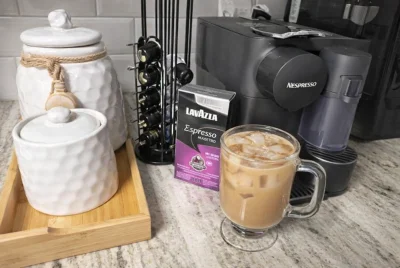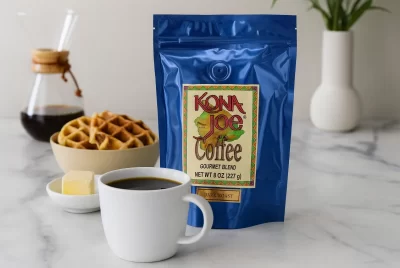Unlocking the Mystery: Does Coffee Have Calories?
*We may earn a commission for purchases made using our links. Please see our disclosure to learn more.
For many of us, sipping on a freshly brewed cup of coffee is an essential start to the day. But as we cherish this caffeine fix, a question lingers in the minds of health-conscious coffee lovers: does our beloved java pack extra calories that could affect our waistlines? It’s easy to pour and enjoy without giving it much thought, but when you’re watching what you eat and drink, every calorie counts.
Here’s something to ponder: A simple mug of black coffee has virtually zero calories—talk about guilt-free indulgence! However, the moment we start adding swirls of cream or spoonfuls of sugar, those numbers can climb.
In this post, we’ll dive into the calorific details that hide in plain sight within our daily brew and offer tips for enjoying your joe without derailing your diet plans. Ready to sip smarter? Keep reading for the full scoop!
The Truth About Coffee & Calories
Coffee itself is a low-calorie beverage, with no calories in black coffee. The calorie content comes from additions like milk, creamer, and sugar.
The Science Behind Coffee
Understanding the energy content of your favorite brew starts with the basic components. Brewed black coffee is essentially water filtered through ground coffee beans, and it’s almost calorie-free.
The minimal calories in a cup come from tiny amounts of dissolved solids and oils naturally found in the coffee bean itself. Since these are present in such small quantities, they add up to about 2 calories per 8-ounce mug according to USDA data.
However, not all coffees are created equal when it comes to calorie count. Introduce milk, creamer, sugar or syrups into the mix, and you’re looking at a different story. These additions can transform your simple sip into a high-calorie treat.
For example, calories in instant coffee with sugar spike because of added sweeteners that increase the caloric value significantly compared to its black counterpart.
Your daily caffeine fix influences your metabolism too; caffeine is known for its ability to boost metabolic rate temporarily. While this does mean that drinking coffee can help you burn more calories at rest, it doesn’t give free rein to indulge without consequences if weight management is on your radar.
Keep track of what goes into your brew if counting calories forms part of your health strategy amidst enjoying each aromatic cup.
The Role of Caffeine
Moving on from the science behind coffee, it’s important to understand the role of caffeine. Caffeine is a natural stimulant found in coffee beans that provides that familiar jolt of energy.
It works by blocking the effects of adenosine, an inhibitory neurotransmitter in the brain, which leads to increased neuronal firing and release of other neurotransmitters such as dopamine and norepinephrine.
This can improve mood, reaction time, memory, and overall cognitive function.
For many people, caffeine is an integral part of their daily routine as it helps them stay alert and focused throughout the day. In fact, studies have shown that caffeine can enhance physical performance by increasing adrenaline levels in the blood and mobilizing fatty acids from fat tissues.
Additionally, some evidence suggests that caffeine may also boost metabolism and aid in fat burning. However, it’s important to be mindful of your overall calorie intake when consuming caffeinated beverages with added ingredients like milk or sugar.
The Role of Coffee Beans
Transitioning from discussing the role of caffeine in coffee, let’s delve into the significance of coffee beans. Coffee beans are where it all begins – they are responsible for imparting the rich and aromatic flavors to your favorite brew.
The type of bean used, its roast level, and origin contribute to the distinctive taste profiles found in different coffees. Additionally, the roasting process plays a vital role in determining whether your coffee will have a light or dark taste.
Specialty coffee drinks often feature specific types of beans that have unique flavor notes such as fruity, nutty, or chocolatey undertones. Understanding these aspects can elevate your appreciation for the intricate world of coffee.
Furthermore, individual preferences regarding bean origins and roast profiles open up a world of exploration for avid coffee lovers looking to indulge their palates with diverse flavor experiences.
Impact of Additions (milk, creamer, sugar)
Adding milk, creamer, or sugar to your coffee can significantly increase its calorie content. For example, an 8-ounce cup of black coffee contains just around 2 calories, but if you add a tablespoon of whole milk and a teaspoon of sugar, the calorie count jumps to approximately 30 calories.
The type and amount of these additives will impact the overall caloric value of your daily cup. It’s important for individuals managing their calorie intake to be mindful about what they’re adding to their coffee.
When making choices about additions like milk and sugar in your coffee, it is essential to consider how they impact the overall calorie count and make informed decisions based on your dietary needs.
The Numbers: How Many Calories Are in Coffee?
Discover the calorie content of different types of coffee, from black coffee to specialty drinks, and learn how additions like sugar and cream can impact the overall calories. Read on for a detailed breakdown!
Black Coffee (espresso, brewed)
Black coffee enthusiasts often enjoy the pure, unadulterated taste of coffee without the extra frills. But what about the calorie count in that morning cup? Let’s break it down.
| Type of Black Coffee | Calories per 8 oz. |
|---|---|
| Brewed Coffee | 2 |
| Espresso | 1 per oz. |
Espresso, often enjoyed for its concentrated flavor, provides around 1 calorie per ounce, making a standard shot a low-calorie option. Brewed coffee, the staple of many people’s mornings, has about 2 calories per 8-ounce mug according to the USDA. Both choices offer a virtually calorie-free experience for those keeping an eye on their intake. Remember, these figures assume you’re not adding any milk, cream, sugar, or flavorings which can significantly increase the calorie content. Enjoying your coffee black is a simple way to savor the beverage without the added calories.
Specialty Coffee Drinks (cappuccino, latte)
Cappuccinos typically contain 60-70 calories per 8-ounce serving, depending on the amount of foam, while lattes can range from 80-150 calories for the same size. The calorie count in these specialty coffee drinks mainly comes from the milk and any added sugar or syrups. Different types of milk and sweeteners can affect the overall caloric content of your favorite cappuccino or latte, making it crucial to be mindful if you’re watching your calorie intake.
Crafting a low-calorie specialty coffee drink is achievable by choosing non-fat or plant-based milk options and cutting back on added sugars or flavorings. Many coffee shops offer lighter alternatives as well as sugar-free syrups to help manage the calorie content while still enjoying your favorite coffee indulgences.
Effect of Sugar & Cream
Adding sugar and cream to your coffee can significantly increase its caloric content. Just a teaspoon of sugar adds about 16 calories, while a tablespoon of cream brings an additional 52 calories to your cup.
If you’re watching your calorie intake, be mindful that these additions can quickly add up. For those looking to manage their weight, opting for alternative additions like non-dairy milk or spices could be a smarter choice as it helps lower the overall calorie content in your daily coffee routine.
The type of milk and sugar added also affects the total calories in your drink. Whole milk contains more calories than skimmed, while sweetened syrups and flavored creams contribute even more.
Healthy Strategies for Enjoying Coffee
- Cutting Calories without Sacrificing Taste
- Alternative Additions (non-dairy milk, spices)
- Balancing Coffee Intake with Dietary Needs
Cutting Calories without Sacrificing Taste
To cut calories without sacrificing taste, consider the following tips:
- Opt for black coffee or espresso instead of specialty coffee drinks loaded with sugar and cream. These options contain minimal calories, especially when consumed without additional sweeteners or flavorings.
- Experiment with non – dairy milk alternatives such as almond, soy, or oat milk to reduce calorie intake while still enjoying a creamy texture in your coffee.
- Use natural sweeteners like stevia or monk fruit extract instead of refined sugar to add sweetness without the extra calories.
- Sprinkle your coffee with spices like cinnamon or nutmeg for added flavor without increasing caloric content.
- Blend your coffee with ice and a small amount of low – calorie flavor syrups for a refreshing yet light treat that won’t sabotage your calorie goals.
- Consider reducing the size of your coffee drink to minimize calorie intake while still savoring the rich flavors and aromas of your favorite brew.
- Be mindful of portion sizes when adding creamers or sugar to your coffee, as even small amounts can significantly increase its overall calorie count.
- Take note of the health benefits associated with different types of coffee and how they can impact weight management efforts, allowing you to make informed choices about your daily caffeine fix.
Alternative Additions (non-dairy milk, spices)
To cut out extra calories while still enjoying your daily cup of coffee, consider alternative additions such as non-dairy milk and spices. These alternatives add flavor and richness without the high calorie content of creamers or flavored syrups. Here are some options to enhance your coffee experience:
- Swap traditional creamer for almond milk or oat milk. Both options offer a creamy texture with fewer calories and less saturated fat.
- Add a sprinkle of cinnamon or nutmeg for a warm, comforting flavor that complements the natural taste of coffee without adding extra sugar or calories.
- Experiment with flavored extracts like vanilla, almond, or hazelnut to infuse your coffee with delicious aromas, without the added sugar and calories found in flavored syrups.
- Consider using unsweetened cocoa powder to create a rich mocha flavor without the excess sugar and calories typically found in chocolate syrup.
- Opt for a dash of unsweetened coconut flakes for a tropical twist that adds sweetness and texture without loading up on additional sugars.
- Try using a small amount of pure maple syrup as a natural sweetener with fewer calories compared to refined sugar or artificial sweeteners.
- Explore the world of spice blends such as pumpkin pie spice or chai spice to elevate your coffee experience with complex, aromatic flavors that are low in calories.
Balancing Coffee Intake with Dietary Needs
Balancing your coffee intake with your dietary needs is essential for maintaining a healthy lifestyle. If you are adding sugar, cream, or flavored syrups to your coffee, then the calorie count increases significantly.
Opting for alternative additions like non-dairy milk or spices can help cut down on unnecessary calories without sacrificing taste. It’s important to be mindful of the added ingredients in your coffee as well as their impact on your overall daily calorie intake.
Considering that flavored coffee drinks can contain hundreds of calories per serving, it’s crucial to find a balance between enjoying your favorite beverage and meeting your dietary goals.
Conclusion
In conclusion, coffee can be a low-calorie beverage when consumed black without any added ingredients. However, the calorie content increases significantly when sugar, creamer, or flavored syrups are mixed in.
It’s important for coffee lovers to be mindful of their choices and consider healthier alternatives like non-dairy milk and spices to enjoy their favorite brew while managing their calorie intake effectively.
So next time you sip on that comforting cup of joe, remember the impact of your additions on its caloric value and make informed choices for a healthier brew.
FAQs
1. Does plain black coffee have a lot of calories?
No, black coffee calorie count is quite low; without added sugar or milk, it hardly has any calories.
2. What happens to the calorie content when I add flavors to my coffee?
When you add ingredients like hazelnut flavor or vanilla syrup, the flavored coffee calorie count goes up compared to plain black coffee.
3. Are there more calories in a special coffee drink like nitro cold brew?
Yes, drinks like nitro cold brew often contain more calories due to added sugars and milk compared with regular black coffee.
4. Do all types of instant coffees have the same number of calories?
Instant coffees vary; some may contain additional ingredients that increase their caloric content while others stick close to traditional black coffee’s low-calorie profile.
5. Can drinking lots of flavored or specialty coffees affect my weight?
Yes, regularly consuming high-calorie beverages like sugary flavored coffees can impact your diet and potentially lead to weight gain if not balanced with other dietary considerations.
6. If I’m watching my calorie intake but love coffee, what should I be aware of?
Be mindful of added sugars and creamy toppings as these increase the energy content in your cup—opt for simpler versions such as straight espresso shots or Americanos if you’re closely monitoring your caloric intake for weight loss purposes.




